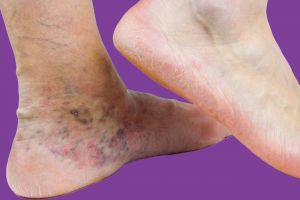Venous Stasis Dermatitis
Venous Stasis Dermatitis
Everything you need to know about
Venous Stasis Dermatitis
Venous stasis dermatitis occurs when your veins, commonly in your lower legs, have a condition that prevents blood from flowing freely. Some blood leaks out of your veins and into your skin when the liquids and pressure build-up.
Venous eczema or stasis dermatitis are other names for the disorder. It is more common in adults over the age of 50. It is more common in women than in men.
Medical treatments can help, but you can also take steps to control the condition on your own.
Symptoms
The first thing you’ll notice is swelling around your ankles. It may improve while you sleep and then return during the day when you are more active. When you stand or walk, your legs may feel heavy.
Other signs and symptoms include:
- Your skin appears reddish, yellowish, or brown around or above your ankles.
- Varicose veins are twisted, bulging veins that are dark purple or blue in colour.
- Itching
- Pain
- oozing, crusting, or scaly sores
- Skin that has thickened around your ankles or shins
- Ankle and shin hair loss
Venous stasis dermatitis Causes
People with circulatory issues are frequently affected. When your veins aren’t functioning properly, blood isn’t returned to your heart as it should be.
One-way valves help blood flow through the veins in your legs. It is their function to force blood up your legs. The valves may stop working properly as you become older or have other health issues. This condition is known as venous insufficiency.
Pressure can build up in some circumstances due to this and other factors. Your skin does not receive enough blood and oxygen.
The following circumstances increase your risk of developing venous stasis dermatitis:
- High blood pressure
- Varicose veins
- Being very overweight
- Heart conditions such as congestive heart failure
- Kidney failure
- A blood clot, especially in your leg
- Many pregnancies
- Past surgery or injury in the area
You’re also more prone to have it if you spend a lot of time standing or sitting and don’t get any exercise.
Venous stasis dermatitis Treatment
Because circulation is the main problem, your doctor may recommend vein surgery. If that isn’t an option, there are alternative ways to get the fluid in your legs moving:
Compression stockings are recommended. They help to reduce oedema and increase blood flow.
Elevate your feet above your heart. Do it for 15 minutes every 2 hours and while you sleep if you can.
Don’t stand still for too long. Take frequent walks.
Your doctor may prescribe a steroid or other treatment to massage your ankles and legs to relieve discomfort, redness, or swelling. If your legs are itchy, an antihistamine pill or lotion may help.
To aid healing, you may need to wrap the area in a medicated dressing. Your doctor will prescribe an antibiotic tablet or cream if you have an infection.
A moisturiser can assist to keep dry skin supple. Choose one that is fragrance-free, dye-free, and perfume-free to avoid irritating your skin. Petroleum jelly and thick creams are both viable alternatives.
Look after yourself
A few simple lifestyle modifications will help you manage your venous stasis dermatitis and prevent it from worsening:
- Take frequent breaks. Take time to move if your profession requires you to sit or stand for long amounts of time. Every hour, go for a 10-minute brisk stroll.
- Exercise. Moving improves blood flow. Consult your doctor about how often you should exercise and which activities are appropriate for you.
- Dress in comfortable clothing. For your legs, compression stockings are a fantastic option, but for the rest of your body, consider loose-fitting cotton clothing. Fabrics that are too tight or too rough might irritate your skin and reduce circulation.
- Look after your skin. It’s possible that your skin will get easily inflamed. When bathing, use only gentle cleansers and soft towels, followed by a fragrance-free moisturiser as soon as possible. Cleaning chemicals, perfumes, grass, plants, pet hair, and anything else that irritates your skin should all be avoided.


